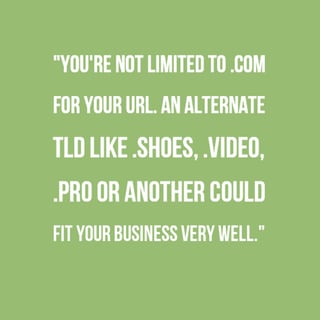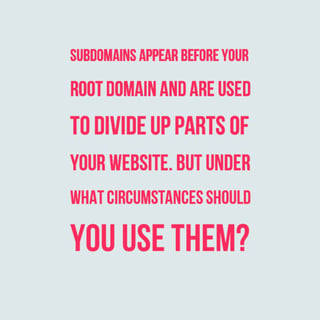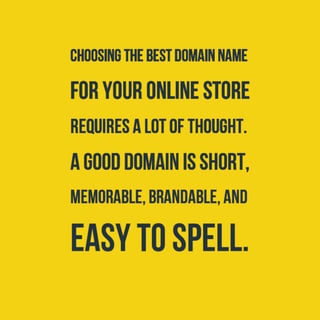
Choosing a domain name when creating an eCommerce website is one of the most important business decisions you can make. As the URL (web address) your customers type into the address bar of their browser, your domain name affects your branding, visibility, search rankings, and more. What with all the competition out there, you need to be memorable, and your domain name can do a lot to help or hinder that.
A bad domain name can make your site hard to find and impossible for customers to remember — and a good domain name can do the exact opposite, firmly establishing your brand in the minds of online shoppers everywhere. This is why it's so important that you choose the right domain name for your business.
Unfortunately, the process isn't always easy. The registration itself is simple, but the steps leading up to it can present a significant challenge if you don't know the details involved. Gaining a better understanding of domain names in general can help you grasp why this is such an important choice for your business, and can help you make an informed decision.
This article will explain the important facts about domain names and provide you with tips for choosing one that will serve your business well.
The Parts of a Domain Name

Domain names are made of three basic parts. For a specific domain name example, we'll use www.3dcart.com. In this domain name:
- www is the server name and stands for World Wide Web. It's the server name used for websites, as opposed to email, FTP or other services.
- 3dcart is the second-level domain (SLD). The SLD is basically the name of the website and should be personalized to your business. More examples: google is the SLD in www.google.com and nytimes is the SLD in www.nytimes.com.
- .com is the top-level domain extension (TLD). The TLD is registered along with the SLD and counts as part of your website's unique web address. There are many TLDs, including .com, .net, .org and more.
So in summary, a domain name can be broken down like this: server name [dot] second-level domain [dot] top-level domain. The SLD and TLD are registered together and are referred to as the root domain. Now we'll get into more detail.
Understanding Domain Names
The "www" part of a domain name is pretty straightforward. The SLD is the business name or the name of the website (or something else that works well). The TLD, however, is more complicated.
Understanding Top-Level Domains (TLDs)
The most common TLD is .com. Others include .net, .org, .biz, .tv, and more. Some TLDs, like .gov and .mil, can only be registered by specific authorized parties such as the government or military. Other TLDs are country-specific, like .uk for the United Kingdom or .fr for France.

Different TLDs were originally intended for specific purposes, with .com meaning "commercial organization," .net meaning "network infrastructure," .org being a catch-all for other organizations, and so on. Today, most of those meanings have faded. As the most popular TLD, .com is commonly used for websites that under the original guidelines would have fit another TLD like .org or .info.
Most people consider .com the "default" TLD, however, this is changing. The popularity of .com means that many desirable .com domains have been taken, creating a need for even more alternate TLDs. In recent years, the list of available TLDs has been greatly expanded and today we have over 1,500 to choose from. Many are specialized for certain intended uses and most of these are self-explanatory, like .video, .club, or .science. Others like .xyz are more open to interpretation.
Especially for eCommerce and retail, the .store domain extension has sprung up as a favorite among brands looking to establish an online store. And rightfully so, since it makes for a perfect and relevant fit for any business that’s “selling”.
The Difference a TLD Makes
Remember that your website's TLD makes up part of your root domain — your unique web address. Even if the rest of the domain name is the same, if the TLD is different it counts as a different domain name and can lead to a different site. For example, www.mazda.com brings you to the Mazda automobile website, but www.mazda.net brings you to a French electric heating and ventilation manufacturer.

Some businesses register multiple versions of their domain with different TLDs to prevent other businesses from purchasing the similar domains. When you register yours, most registrars will display a list of similar domains, urging you to register them too in order to protect your brand. You won't need the alternate TLDs that have nothing to do with your business (like .space, unless you're selling astronomy equipment), but consider registering some of them just in case. If your domain name includes a commonly misspelled word, consider buying the misspelled version of your domain name too. You can direct all your domains to the same website.
Customers can get confused by similar domains and end up on the wrong site. This is the last thing you want — first-time customers can be unforgiving and give up immediately if they can't find your site on the first try. Thankfully, you can avoid this scenario as long as you keep a few things in mind:
- Before you register your domain, check if a similar .com name is in use and if it could potentially be confused with your own site. Consider altering your intended domain name to be less similar.
- Make an extra effort to choose a descriptive, memorable domain name that can't be mixed up with another (we'll explain how later in this article).
- If the .com name you want is taken, don't simply pick the same name under an alternate TLD unless you've carefully evaluated your options and checked where the .com domain leads.
If you put enough thought into your domain name and your branding, there will be no risk of your site being confused with others.
The .com Bias
It's very common for people to prefer the .com TLD above the other options when choosing a domain. Many assume .com websites are given better positions in search results, but the superiority of .com is debatable.
Google never favors one TLD over another. The only possible exception is for region-specific searches like "plumbing repair in London" in which case a site with the .london TLD may receive a geotargeting advantage once Google analyzes how this kind of TLD is being used.
Since Google has stated that there's no SEO advantage to using a .com name, you're free to exercise more creativity when choosing a domain for your online store. You could even use a TLD that's part of the name of your business, like a movie store called American Classic Video choosing www.americanclassic.video for their domain.
Subdomains
A subdomain is an optional part of a domain name that replaces the server name (www), such as in blog.3dcart.com. Subdomains are a means of dividing up areas of your website. This can be useful for organizational purposes or for optimizing your site for different regions. For example, if your business has offices in both the US and Canada, you could redirect Canadian visitors to canada.yourdomain.com, a version of your site with information specifically for Canadian customers.
Another example would be to provide multilingual versions of your website. Wikipedia uses subdomains this way: en.wikipedia.org brings you to the English language site, while other languages have different subdomains (like Italian at it.wikipedia.org, Spanish at es.wikipedia.org, and more). Subdomains are a great solution for an international organization to display content to visitors in their own language.
Subdomains are also handy if different parts of your website require different software platforms to serve different purposes, like installing forum software under forum.yoursitename.com. Subdomains allow a large website to split itself up as needed while still keeping everything under the same root domain.
Subdomains can also be used for different versions of a website for different devices, like m.examplename.com providing a mobile version to which users browsing on a phone would be redirected. However, Google favors responsive design instead, in which a single version of a website is optimized for all devices.
When to Use Subdomains
Whether you should use subdomains depends on how your website should be structured to meet the needs of your business. An international business could follow Wikipedia's example and use subdomains to create multilingual versions of their site. A business that already has a complete website, but wants to add an online store, could create store.examplename.com to house their catalog.
This works because subdomains are functionally separate websites with their own structure. Some domain registrars charge for each subdomain for this very reason. Not every site needs to use subdomains, and most are fine keeping different parts of their site in a subdirectory instead. A subdirectory is a folder on your website and appears after the domain name, like www.examplename.com/blog/.
So, which are better, subdomains or subdirectories?

That depends on the organizational needs of your website. According to Google's Webmaster Trends Analyst John Mueller, subdomains do not have a big impact on your SEO — Google recognizes the different uses for subdomains and subdirectories and Google's algorithms are able to "figure out" what the website is trying to accomplish. However, you can't rely on this completely, because in practice there have been inconsistent results. If you use subdomains, you'll still need to ensure that each is optimized for search engines, so plan carefully to stay within the limits of your business's resources.
Overall, unless you can think of a specific reason you need subdomains, many experts consider subdirectories the better option.
Domain Name Service Providers
The main service providers for domain names are domain registrars.
- Google Domains is a great registrar that also offers free domain privacy.
- Namecheap is another highly-regarded registrar.
- Others include GoDaddy, Hover, 1&1, and many more.
The best is to check a full list of domain registration providers and compare their offerings and pricing.
Domain name generators are available to help you come up with a great domain name.
- Lean Domain Search generates possible domain names based on your chosen keyword.
- Another is Name Mesh, which works similarly but lets you add multiple keywords into the equation.
- A third is Business Name Generator from Cool Name Ideas, which provides tools to help you name your business and also checks if a matching domain and Twitter username are available. This one is especially helpful if you're just starting out and still need a business name.
How to Choose the Best Domain Name
Now that you know more about domain names and how to get one, it's time to come up with your very own! There are two possible starting points that depend on the state of your business:
- Option 1: You're just starting out and you have yet to name your business, or you don't feel attached
 to a name that you have chosen. In this case, you can be flexible with your domain name choice and could even name your business after the domain that works best for you.
to a name that you have chosen. In this case, you can be flexible with your domain name choice and could even name your business after the domain that works best for you. - Option 2: You're already established in some manner — maybe you already run a successful brick-and-mortar store, or you've been doing business on a larger marketplace like Amazon or Etsy, and now you want an online store of your own. In this case, you've already been working on your branding, and the domain name you choose should be compatible with what you've built so far.
Either way, the same best practices for choosing a domain name apply. Follow these guidelines, and you'll arrive at a domain name that is brandable, enticing, and overall great for your business.
Keep it short and simple.
Shorter domain names are much easier to remember, and it's very important that nothing about your domain name is confusing when spoken aloud. Imagine talking to a stranger about your business and telling them your site's URL. You don't want to have to clarify anything or spell anything out, and you don't want the person to forget your domain before they get a chance to visit your website. You may want to test your domain by saying it to friends and seeing if they can write it properly. For instance, a domain name such as thewardrobe.store is short, simple, and easy to remember and spell.
It must be attention-grabbing and brandable.
You want to catch the interest of potential customers immediately with a domain name that will support your efforts to build your brand. Google recommends including your unique brand name in your domain in order to help it gain recognition. Your domain name, your brand, and your website's design should all reflect one another. Related, choose a name that's also available across social media platforms like Facebook and Twitter, so your business can be found consistently across all networks.
It must be relevant.
Your domain should make it clear to your visitors what they can expect by visiting your site, so it's a good idea to include a keyword related to the products or services you offer. Keep this keyword broad, so as not to constrain your business too much in case you want to expand your offerings in the future. Do not stuff several keywords into your domain name — this looks spammy and low-quality, and will not help you rank. If your business name already includes such a keyword, "Joe's Hardware" for example, even better (in fact, it's a good idea for business names to be at least somewhat descriptive of the nature of the business). Additionally, if you prefer to sell locally or to a specific region, you can add that too, e.g. "Joe's Hardware Miami."
Choosing a relevant domain extension for your online store is another tactic to find a keyword-rich name without making your domain name longer. For instance, Emirates chose www.emirates.store (and not www.emiratesstore.com) for its “online store”, while their primary website is www.emirates.com.
Don't use numerals, "chat speak," or hyphens.
Numerals just confuse matters, especially if you use them to replace words like 2 for "to" and 4 for "for." The exception to this rule is if your business name actually has a numeral in it — in that case, it's part of your branding. Don't replace words with single letters, either, like U for "you." This goes with the previous rule on clarity, and besides, chat speak in your URL looks unprofessional. Hyphens are another mistake; they're annoying when saying your domain name aloud, they're hard to remember because the norm today is to have all the words in your domain together "like one word," and they're frequently associated with spammy websites. For example, couch.com is a much stronger brand name and URL than best-couches.com. The simpler your URL, the simpler it will be for customers to remember it.
Don't use confusing words.
Avoid words that are hard to spell or easy to confuse with a similar-sounding word. Again, think of clarity and ease of remembering. This also means you should avoid puns (no matter how tempting you may find them).

Additionally, take care to avoid words that mean something inappropriate in another language, and words that turn into something unintended when crammed together.
This will kill your brand and make you the butt of jokes all over the internet.
For best results, show others your intended domain name and see if they can spot anything — they might see something you don't.
You can't use special characters.
All special characters, like &, %, $, etc., are excluded from domain names, as URLs use them for other functions. If your business name contains a special character, you're going to have to replace it with a word ("and," "percent," "dollars," etc.) regardless of your branding.
Research it first.
Ensure your desired domain name isn't trademarked or copyrighted by someone else. You can check this online at the United States Patent and Trademark Office and the United States Copyright Office. Don't use the names of existing products or brands, either. You also need to be sure your domain wasn't used in the past by someone who earned it a bad reputation, including a possible Google penalty. You can research previous domain owners (if any) through Whois History, view past versions of a website on the Wayback Machine, and get a good understanding of Google's stance on the domain by searching with the site operator (a Google search of site:examplename.com). If nothing comes up, you're golden.
Registering a Domain Name
Registering your domain name is a straightforward process. To register, visit the website of a domain registrar that offers the TLD you are looking for. If you have your eye on a specific TLD, you may have to search for a registrar that offers it at a good price. You'll need to pay with a credit card or PayPal, although some registrars may accept other forms of payment as well.
When you register your domain name, it's important that you use real contact information in order to comply with the rules of ICANN (Internet Corporation for Assigned Names and Numbers). False contact information is grounds for domain cancellation. However, you are usually able to purchase domain privacy protection to hide your personal information from the public.
You can register your domain for one or more years, and will need to renew it when your time is up. Discounts are usually offered for longer registration terms. You don't need to have your website already set up — you can simply "park" the domain until ready for use.
If you choose to switch registrars (maybe for a reduced renewal fee), it's usually possible to transfer to another, although there may be limitations depending on the TLD you have chosen.
Registration Fees
The registration fee for your domain name is heavily dependent on the TLD. Some cost only a few dollars and some others run into the thousands. This makes your budget another factor to consider when coming up with domain name options — don't just check the availability, check the pricing too!
Final Thoughts (and One More Piece of Advice)
Now, you're armed with the knowledge you need to create and register the best domain name for your online store. Google's guide to choosing a domain name makes another important point — a good domain is more important than a perfect one. If you spend too much time agonizing over your decision, you're taking time away from building your brand and getting your business rolling. Follow these guidelines as best you can, but allow yourself some flexibility and creativity. Those, above all, will help you create a fantastic domain name that will serve your business well into the future.





Leave a reply or comment below